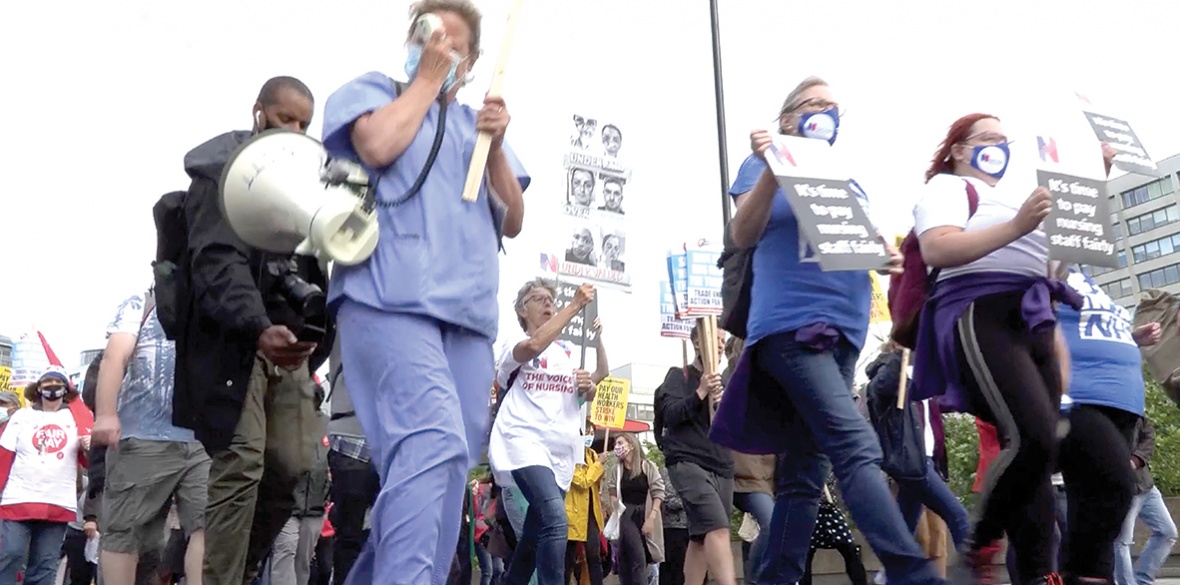This is the last article you can read this month
You can read more article this month
You can read more articles this month
Sorry your limit is up for this month
Reset on:
Please help support the Morning Star by subscribing here
THE struggle over the level of public-sector pay rises for 2025 has already begun. Because of its impact on general pay increases, the outcome will be of direct interest to all workers.
In addition, because of the multiple crises in public services, wider society has an interest in a level of pay that improves the deteriorating record in recruitment and retention in key parts of the public sector.
As a result, the outcome of this struggle will have serious consequences for the entire working class and the poor. There is also the possibility, or even the likelihood, that this will be a multi-year struggle as the government’s own budget suggests that ministers’ aim will be continuous belt-tightening over the lifetime of this parliament.
The backdrop to the fights over pay is not as widely understood as they should be, even among trade unionists and the left.
It has been the deliberate intention of successive governments to use public-sector pay restraint as a double-edged attack on workers.
The first is governments using below-inflation pay settlements to curb the growth in public spending and provide tax cuts to businesses, and frequently to the highest-paid too.
The second is the effort to use paltry pay rises in the public sector to set a “going rate” for the economy as a whole; to keep wages down across the board.
This repeated suppression of the natural growth in public-sector pay has led to both a fall in real terms for many (adjusting for inflation) as well as a recruitment and retention crisis in many sectors. This is particularly evident among teachers and has reached crisis proportions among nurses in the NHS.
These were among the underlying causes of the huge wave of public-sector strikes that began after the surge in inflation in 2022.
Well over 5 million workdays were lost to strikes in 2022 and 2023 combined, by far the biggest wave of industrial action since the miners’ strike in 1984 and 1985 (although the days lost in the titanic miners’ strike were very much larger).
Even more important, the strikes were largely successful. The Tory government intervened in areas like rail to bail out the rail companies as long as they held firm on pay.
But the government eventually lost overall, with some important exceptions, and the new Labour government conceded to organised workers.
But in virtually no cases has the pay settlement been anything like what would have been necessary to restore real pay differentials that have been eroded over decades.
More importantly, as noted above they have not been enough to prevent the immiseration of highly trained workers and many of them voting with their feet to move to better paid and/or lower stress jobs.
For some, simply moving to a job where it is not routine to do unpaid overtime to cover for chronic staff shortages is a sharp improvement in their quality of life.
It is no accident that the RCN (Royal College of Nursing) and the NEU (National Education Union) have been at the forefront of criticism of the government’s proposed 2.8 per cent public-sector pay review bodies. They are among the hardest hit by the effective reduction in real pay over the long run.
But the anger is far from confined to these two unions, or even these two sectors. Pointing to the crises of recruitment and retention, TUC general secretary Paul Nowak said: “There are real concerns across the trade union movement about the government’s recommendation.
“It’s hard to see how you address the crisis in our services without meaningful pay rises. And it’s hard to see how services cut to the bone by 14 years of Tory government will find significant cash savings.”
No doubt individual trade unionists on the front line could express themselves in even more forthright terms.
The anger has a real basis. The Office for Budget Responsibility reckons that inflation will be at 2.6 per cent next year. As all forecasts have a margin of error, the proposal for 2.8 per cent could be at or even below inflation, if imposed.
Clearly, workers need and expect a continuous restoration of former pay in real terms, yet ministers seem to believe that last year’s settlement was a one-off. There is a fundamental difference of perception here, a gap that can only be bridged with money.
Instead, ministers have begun to talk about efficiency savings and increased productivity in fevered terms. Every government that ever comes to office does so. Which does not mean that no savings can be found, but unless government thinking alters radically, there will be no genuinely new savings.
That new thinking would need to include removing the enormous drain on public resources that arises from PFI payments. This drain now amounts to billions of pounds from the NHS budget alone, which could be better, more efficiently used by the NHS itself.
When ministers talk about difficult decisions and tough choices, there are no tough choices for the PFI firms who are laughing all the way to the bank. An easy choice would be to cut them out of the public sector altogether.
It really is nonsense to talk about bigger pay rises than the 2.8 per cent proposal being dependent on increasing productivity. Nurses cannot simply run around the wards, administer drugs, or help a sick patient from their bed any quicker.
As public services, the NHS, education, local authority services, and yes Civil Service administration are people-intensive sectors. But to improve their productivity requires significant capital investment.
That is capital investment so buildings are not dilapidating and new replacements are built, IT systems that are not clapped out and can be integrated with one another, record-keeping that is electronic and accessible, and so on.
It is also vital to provide affordable housing to ensure that workers are not exhausted by their daily commute.
Yet the government is doing none of this. Instead, it is threatening 10,000 Civil Service job cuts.
After a one-off rise in 2025/26, there will be cuts to departments’ capital spending. Anything not fixed in the next 18 months or so will get worse.
Day-to-day or “resource spending” will fall away sharply in future years after a short-lived rise. After 2026, the real increase in these budgets will be less than 2 per cent a year.
This is supposed to cope with rising demand for services, fix current crises and meet fair pay settlements. It is impossible.
Renewed austerity is already starting to bite and will get worse on every front unless government is forced to change course.
Diane Abbott is Labour MP for Hackney North and Stoke Newington. Follow her on X @HackneyAbbott.







